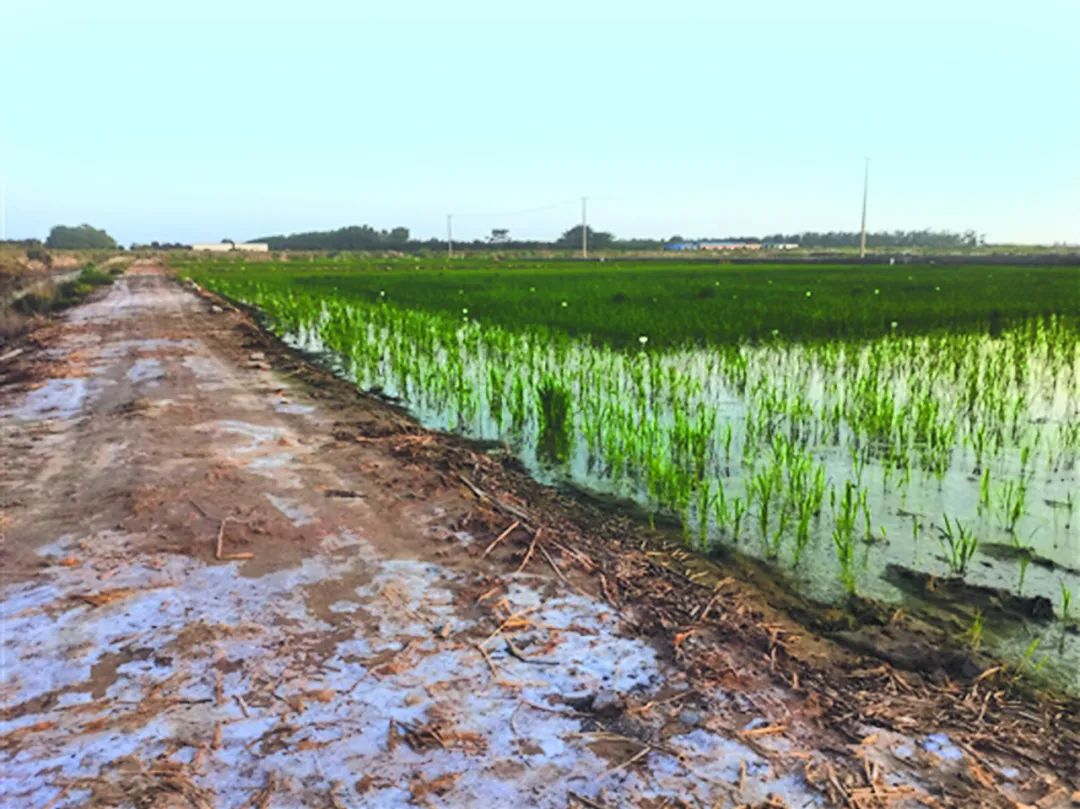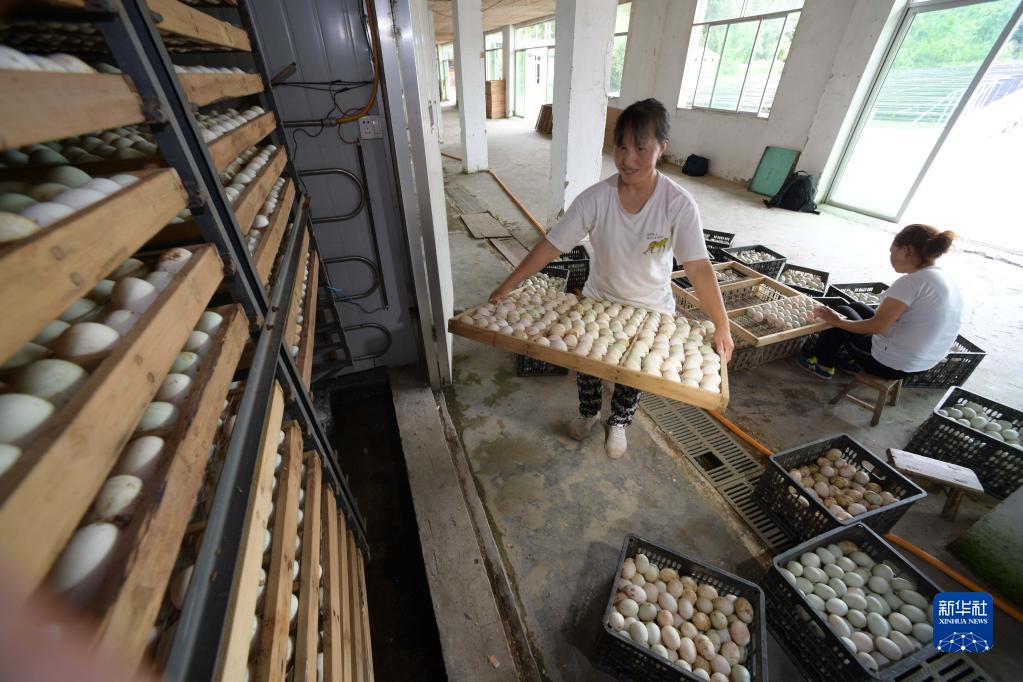Plant grass!Li Zhensheng's "coastal straw belt" youth commando team, the third battle of saline -alkali land requires grain
Author:Journal of China Science Time:2022.08.10
Text | "China Science News" reporter Feng Lifei

Scientists carry out breeding work in white flowers or watery salt -alkali land. Interviewee confidence
The car galloped on the flat highway in Dongying, Shandong, and the green grass and a piece of pond flying across the window passed. The reporter opened the box of Li Hongwei's words about the planting of Dongying's long spike wheat grass.
"It was 70 acres at the beginning of 2020, 130 acres last year, and 200 acres this year." He did not think about "pouring out" a series of numbers.
Li Hongwei is an associate researcher at the Institute of Genetics and Development (hereinafter referred to as the Genetic Development) of the Institute of Genetics and Development of the Chinese Academy of Sciences. He looks unsmiling, but it is very interesting to talk about the breeding test of the pupae grass. "Through the experiments in recent years, we found that the yield of long -ears can reach more than 2,600 kg in the medium -weight saline -alkali land with a salt content of 3 ‰ to 5 ‰, which can be reached more than 2,600 kg. Can survive. "
As a member of the "Coastal Grass Belt" youth commando of the Institute of Genetics, Li Hongwei and his teammates have a clear goal: to benefit the saline -alkali land.
A battle
On a land about 10 kilometers away from Huanghekou, the Chinese Academy of Sciences, including Li Hongwei, launched the third battle to ask salt -alkali land.
The first two battles were the "Huanghuaihai Battle" and "Bohai Grain Grain" plan.
In the 1980s and 1990s, Li Zhensheng, an academician and wheat breeding expert of the Chinese Academy of Sciences, proposed the proposal of Huanghuaihai's low -production field governance, and organized the implementation of the "Huanghuaihai Campaign" of agricultural science and technology. Essence
In 2013, Li Zhensheng, who won the National Supreme Technology Award, was put into a new battle -the organization and implementation of the "Bohai Greece" plan to achieve more than 20 billion catties in the Bohai Rim region.
As of 2021, China's grain production has achieved the "eighteen consecutive" since the new millennium, and the grain output has stabilized more than 1.3 trillion kg for 7 consecutive years. my country's per capita grain share reached 483 kg, which is higher than the internationally recognized 400 kg safety line.
However, with the economic development and consumption upgrade, the food consumption structure of residents in my country has undergone subversive changes: the proportion of total ration consumption in the grain consumption structure decreased from 72%to 27%(1985 ~ 2017). In contrast, the consumption of per capita meat and egg milk has increased by nearly 3 times, which makes the raw grains that produce feed grains in my country to half of the total grain output of the annual feed grain.
In addition, my country needs to import a large amount of pasture and beef and mutton every year. According to statistics, in 2021, soybeans, oils, and meat imported by my country are equivalent to 900 million mu of grain output.
The limited cultivated land area determines that the cultivation of grass material in my country cannot be "fighting with the main grain." How to ensure the safety of feed food?
In 2020, Li Zhensheng, nearly 90 years old, has proposed the construction of the "coastal straw belt" again according to the breeding test of Caofeidian, Haixing, Nanpi, Dongying, etc. Nearly 20 million acres of saline -alkali land in the region and other coastal areas.
The planting environment of the "coastal straw belt" determines that the appropriate pasture varieties must have the characteristics of salt tolerance and waterlogging. However, since my country was reviewed in 1978, there were 604 pastoral varieties approved by the state, of which there were less than 20 salt -tolerant and pastoral varieties, and there were very few good pastoral varieties with salt tolerance and waterlogging characteristics.
In this context, Li Zhensheng's "Coastal Grass Belt" youth commando was established in the Institute of Genetics, and more than a dozen breeding and breeding teams of breeding and breeding teams were set up. Featured pastoral resources.
Inheritance
Standing in front of the bean seedlings of the President of the Dongying Demonstration Base, the assault team members and associate researchers Zhou Guoan and Liu Shulin could not hide their inner joy.
They also remembered the experience of "Waterloo" in the first year of the first year in Dongying's soybean -the sown seeds were almost overwhelmed, and the seedling rate was nearly zero.
During the drought, it was like a layer of white crystal salt, and the ponds were instantly turned into a pond when the fields were flooded. "This makes the soybean sowing window period very short." Liu Shulin said that the species of species in such a test field was very high.
In the next three years, under the leadership of the project team leader Tian Zhixi, according to the planting model of the local farmers' complete natural rain, thousands of soybean materials were screened, tested, and eliminated ...
Finally, they received two high -quality saline -resistant soybean varieties in 2021, and the yield in the heavy saline -alkali land with a salt content of up to 5 ‰ in Dongying reached more than 520 pounds, far exceeding the current average yield of ordinary arable soybeans in my country (264.8 kg of 264.8 catties To.
"Breeding is a very tedious process, but the spirit of overcoming difficulties still need to have it." From the "Huanghuaihai Campaign" to the "Bohai Greece" demonstration project, several generations of Chinese Academy of Sciences once took root in saline -alkali land, and the wind came in the rain. Go, forget me. In Zhou Guoan's view, it is necessary to inherit the spirit of the older generation of scientists in agricultural research, and we must not be afraid of suffering.
In 2018, Cao Xiaofeng, an academician of the Chinese Academy of Sciences and a researcher at the Institute of Genetics, led the team to undertake the "marginal land energy efficiency expansion mechanism and the technical model of the land -hiding food" in the key deployment project of the Chinese Academy of Sciences. The important ideas of marginal land biological improvement uses the cross advantages of molecular biology, microbiology, and soil repair studies to choose a marginal land such as northeast soda salt -alkali land, coastal saline land in the Yellow Triangle area, and southern red soil. The Cao Xiaofeng team collaborated with the Heilongjiang Academy of Agricultural Sciences and the Grass Industry Institute of Grass Industry, which collected more than 800 plant germplasm resources, and conducted a large -scale screening in soda saline -alkali land in Northeast China. Very strong bean family -Tian Jing.
"Tian Jing has the characteristics of salt resistance, alkali resistance, waterlogging, barren resistance, etc. It still grows very well in saline -alkali land with a salt content of 6 ‰ and pH of 9 or more, and has strong nitrogen fixation capacity, large biomass, high protein content as high as up to up to up to up to up to up to up to up to up to up to up to up to up to up to up to up to up to up to reach More than 20%. "Cao Xiaofeng team young researcher Deng Xian said.
According to reports, since the implementation of the project in 2018, the team has carried out planting and breeding in many places in Heilongjiang, Shandong, Beijing, Hainan and other places. Planting fields can significantly improve the physical properties of the soil, significantly improve the quality and fertility of the soil, and acres of acres. The amount of fresh grass can reach 2.5 ~ 3.5 tons.
"Green fertilizer is the essence of Chinese farming civilization, but now we do not use it well, mainly because there is no economic benefits after planting. Our purpose is to improve its biomass, protein content, and palatability through molecular breeding and other technologies. , Give full play to the comprehensive value of its feed and fertilizer. "Deng Xian said.
Wang Jianlin, Captain of the Assault Team and Director of the East Camp Molecular Breeding Center of the Institute of Genetic Development, introduced that the current demonstration planting area of the East Camp Base of the Genetic Development Institute has reached 1,000 acres. The selection of 7 crops such as the seeds played an important role and made important progress.
For example, salt -tolerant rice is produced with 3 ‰ of 3 ‰ of micro -saline water on 6 ‰ saline -alkali land, and the perurone is 515.31 kg, and the rice quality reaches the first -level national standard. The grass production can reach 4-7 tons per acre. These varieties (departments) provide a source of species for the implementation of the "coastal straw belt" strategic concept.
A hope
At the Dongying Base, the long spikema grown planted three years ago has grown to shoulder high.
"At present, the thinking of grain in salt -alkali land in my country has changed: from adapting to plants in the treatment of saline -alkali land, to breeding plants to adapt to saline -alkali land." Wang Jianlin said that from screening for salt -resistant quality resources, creating a new type of salt resistance, to innovation and cultivation The technical model and the creation of the entire industrial chain of saline -tolerant crops, and truly contribute to ensuring the safety of national feed food. The next step, the "assault team" players are still long -term.
As we all know, my country's soybean import dependence is as high as 80%, and most of the soybean meal is used for feed production. With the preliminary selection of saline -tolerant soybean species resources, Liu Shulin and Zhou Guoan still have many goals: continue to cultivate soybean varieties with higher saline -tolerant, such as the quality of saline -alkali land with a salt of 10 ‰; Enterprises and local cooperation do a good job of promoting varieties so that the effectiveness of scientific research work is implemented.
"After the pupae seeds are finished next year, they will plant a demonstration place of 1,000 acres, and then expand the area to promote it." This is Li Hongwei's hope.
"China Science Journal" (2022-08-10 The first edition of the original title "" Planting grass "on the Yellow River Exit")

Edit | Zhao Lu
Capture | Zhihai

- END -
Guizhou Sansui: Promote the improvement of quality and efficiency of the traditional hemp duck industry

On June 22, workers put the planting duck eggs into the incubation warehouse in th...
so crazy!Gold is selling again!The post -95s and post -00s are also "robbed"!This type of product is the most "fire" →
NowThe gold market is no longer just a home for parents and momsAfter the 95th and 00s, they didn’t hand softly when they bought goldCompared to gold chain, gold braceletOnly 1 gram of golden beans